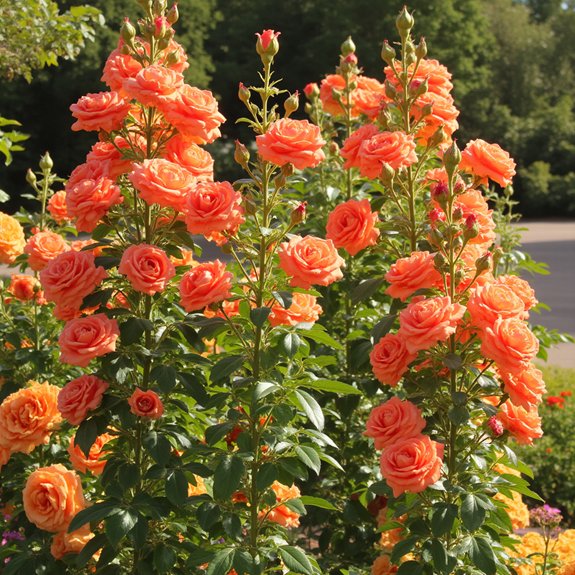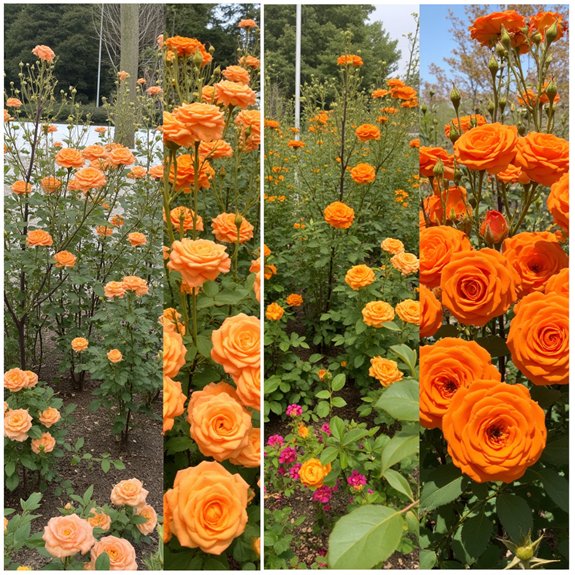Orange roses bring remarkable warmth to gardens, offering colors from soft peach to deep copper-orange. These versatile plants thrive in zones 5-9, requiring six hours of direct sunlight daily. Lady Emma Hamilton produces fragrant, ruffled blooms reaching 4-5 inches across, while Ring of Fire displays striking orange petals with red edges. Most varieties bloom continuously from May through October, growing 3-6 feet tall depending on type. However, choosing the right companion plants makes all the difference in creating spectacular displays.
Contents
- 1 Top Orange Rose Varieties to Transform Your Garden
- 2 Understanding the Appeal of Orange Roses in Landscape Design
- 3 Essential Growing Conditions for Thriving Orange Roses
- 4 Fragrant Orange Rose Varieties and Their Unique Scents
- 5 Bloom Seasons and Flowering Patterns Throughout the Year
- 6 Perfect Plant Companions for Orange Rose Gardens
- 7 Growth Habits and Size Considerations for Different Varieties
- 8 Distinctive Bloom Characteristics and Color Variations
Top Orange Rose Varieties to Transform Your Garden

When gardeners seek to infuse their landscapes with warmth and vibrancy, orange roses deliver an unmatched combination of bold color and enchanting fragrance. These stunning varieties transform ordinary garden spaces into dynamic showcases of energy and charm.
Ring of Fire produces classic hybrid tea blooms reaching 4-5 feet, while Lady Emma Hamilton offers cupped tangerine flowers with citrusy scents at 3-4 feet tall. Orange rose symbolism represents enthusiasm and desire, making these varieties perfect focal points. Orange rose care requires full sun exposure and regular deadheading for continuous blooms through frost, ensuring spectacular seasonal displays.
Understanding the Appeal of Orange Roses in Landscape Design
The magnetism of orange roses in landscape design stems from their remarkable ability to serve as both focal points and shifting elements within garden compositions. Their vibrant energy creates visual warmth that draws attention without overwhelming neighboring plants. Color symbolism plays a significant role, as orange represents enthusiasm, creativity, and liveliness in garden spaces.
Seasonal aesthetics benefit tremendously from orange roses’ dynamic presence. They complement cooler blues, purples, and greens naturally, creating balanced color schemes. These roses shift beautifully from spring’s soft apricots to summer’s intense tangerines, maintaining visual interest throughout growing seasons while adapting to changing garden moods.
Essential Growing Conditions for Thriving Orange Roses

Success with orange roses begins with understanding their fundamental sunlight requirements, which directly impact both bloom production and overall plant health. Most varieties thrive in full sun locations, receiving at least six hours of direct sunlight daily.
Proper soil requirements include well-draining earth with a pH between 6.0-7.0. Clay soils need organic matter amendments, while sandy soils benefit from compost additions for moisture retention.
Effective watering techniques involve deep, infrequent irrigation rather than frequent shallow watering. Water at soil level to prevent leaf diseases, applying one inch weekly during growing season. Morning watering allows foliage to dry quickly.
Fragrant Orange Rose Varieties and Their Unique Scents
What sets orange roses apart from other garden varieties often lies not just in their vibrant color, but in their remarkable range of fragrances that can transform any outdoor space into an aromatic paradise.
Different scent profiles emerge from popular orange varieties, each offering distinct aromatic experiences. Ring of Fire delivers mild rose tea fragrance, while Double Easy Orange produces fruity notes. Lady Emma Hamilton showcases citrusy scents that complement its tangerine blooms.
Fragrance intensity varies considerably across varieties. At Last features intense sweet perfume, contrasting with Lady of Shalott’s apple cider scent. Nelson Mandela offers spicy notes, while Roald Dahl combines tea-rose and citrus fruit fragrances for complex aromatic appeal.
Bloom Seasons and Flowering Patterns Throughout the Year

When do orange roses reach their peak blooming potential, and how can gardeners maximize their flowering display throughout multiple seasons? Most orange roses bloom continuously from spring through frost, with proper bloom timing management. Continuous bloomers like Ring of Fire and Tangerine Skies provide sustained color throughout growing months. Regular deadheading encourages repeat blooms, while seasonal care adjustments optimize flower production. Some varieties require establishment time before blooming profusely, though early blooms appear within the first year. Peak flowering occurs during warm summer months when plants receive adequate sunlight and consistent watering schedules.
Perfect Plant Companions for Orange Rose Gardens
While orange roses create stunning focal points on their own, selecting the right companion plants transforms ordinary gardens into extraordinary displays of coordinated color and texture. Light blue perennials provide striking contrast against vibrant orange blooms, creating visual depth in any garden design. Hot pink gomphrena adds excitement to mixed borders, while silver-leafed plants like Dusty Miller or Silver Sage create elegant backdrops. Cool purples and greens naturally complement orange’s warmth, balancing energetic displays. These companion plants enhance orange roses’ natural beauty without overwhelming their cheerful presence, resulting in sophisticated garden compositions that bloom harmoniously throughout the growing season.
Growth Habits and Size Considerations for Different Varieties
Size matters greatly when planning orange rose gardens, as these perennials range from compact 2-foot shrubs to towering 8-foot climbing varieties that dramatically alter garden landscapes. Understanding size variations helps gardeners choose appropriate locations and avoid overcrowding issues. Compact varieties like Amour de Molène reach just 2-4 feet, making them perfect for smaller spaces or front borders.
Growth requirements differ greatly between varieties. Nelson Mandela displays strong upright growth reaching 5-6 feet, while Vavoom maintains a neat rounded habit at 3-4 feet. Lady of Shalott offers versatility, functioning as either shrub or climber depending on training methods chosen.
Distinctive Bloom Characteristics and Color Variations
Orange roses showcase remarkable diversity in their flower forms, ranging from delicate single petals to voluminous double blooms that create stunning focal points throughout growing seasons. The bloom colors span from soft salmon-coral tones in ‘Amour de Molène’ to vibrant tangerine hues in ‘Lady Emma Hamilton’.
Flower shapes vary dramatically across varieties. ‘Nelson Mandela’ produces semi-double bright orange flowers, while ‘At Last’ features fully double golden apricot blooms. ‘Roald Dahl’ displays distinctive peony-shaped flowers in delicate apricot, and ‘Just Joey’ creates lush coral blooms with characteristic wavy petals that add textural interest to garden displays.
